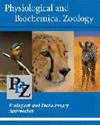A Modern Overview of Crustacean Biogeography: Evolution and Biogeography Review
IF 1.8
3区 生物学
Q3 PHYSIOLOGY
引用次数: 0
Abstract
Martin Thiel continues his ambitious and successful role as series editor for Oxford’s Natural History of the Crustacea. Volume 8 (Evolution and Biogeography) includes 18 chapters that discuss crustacean evolution and emergent patterns (and causal mechanisms) underlying the biogeography of Crustacea in marine, freshwater, terrestrial, and subterranean habitats. As is often the case with edited volumes, some chapters are stronger than others, but overall, this is a book most invertebrate zoologists, marine biologists, and biogeographers will want on their shelves. Because of its emphasis on review chapters, the volumewill be especially useful for beginning researchers and those who are not crustacean specialists. Five chapters focus on the evolution of Crustacea. Among the strongest is Shane Ahyong’s summary of current views on crustacean evolution (“Evolution andRadiation of Crustacea”), noting that over the past two decades, our phylogenetic perspective has shifted from a long-bodied, serially homonomous ancestry (as seen in remipedes and cephalocarids; an idea promoted by Howard Sanders, Bob Hessler, and Fred Schram and one that many of us “cut our teeth on”) to a short-bodied, possibly ostracod-like ancestry similar to Cambrian stemand crown-group fossil forms. Ahyong correctly acknowledges the importance of the Orsten fauna as a key lens through which to understand the early evolution of Crustacea, noting that the oldest definitive crustacean fossils are upper Cambrian Orsten of Sweden—small, just millimeters in length, but exquisitely preserved specimens owing to their phosphatic preservation. Earlier ideas of long, serially homonomous ancestry had been influenced by two scientifically flawed lines of reasoning. First was an underlying notion that evolution moves from simple toward more complex. Second was a reliance on largely untestable narratives of ur-crustacean bodymorphology as a starting point (i.e., the hypothetical ancestor approach). The new view, of Pancrustacea comprising the two great clades Oligostraca and甲壳类生物地理学的现代综述:演化与生物地理学综述
马丁·蒂尔继续他雄心勃勃和成功的角色,牛津大学的甲壳类自然史系列编辑。第8卷(进化和生物地理学)包括18章,讨论了甲壳类动物的进化和新兴模式(和因果机制),这些模式是海洋、淡水、陆地和地下栖息地甲壳类动物生物地理学的基础。就像编辑过的书一样,有些章节比其他章节更有力,但总的来说,这是一本大多数无脊椎动物学家、海洋生物学家和生物地理学家都想要放在书架上的书。因为它强调的回顾章节,卷将是特别有用的开始研究人员和那些谁不是甲壳类专家。五章重点论述了甲壳类动物的进化。其中最有力的是Shane Ahyong对当前甲壳类动物进化观点的总结(“甲壳类动物的进化和辐射”),他指出,在过去的20年里,我们的系统发育观点已经从一个长身体、序列同源的祖先(如雷足类和头足类;这一观点是由霍华德·桑德斯、鲍勃·赫斯勒和弗雷德·施拉姆提出的,我们中的许多人都“初步接受”了这一观点),认为它是一种身体短小、可能类似于甲壳类动物的祖先,类似于寒武纪的茎类和冠类化石形式。Ahyong正确地认识到Orsten动物群作为了解甲壳类动物早期进化的关键透镜的重要性,并指出最古老的甲壳类动物化石是瑞典的上寒武纪Orsten -很小,只有毫米长,但由于它们的磷酸盐保存而保存得很好。早期关于祖先同源的长期观点受到了两种有科学缺陷的推理路线的影响。首先是一个潜在的概念,即进化从简单走向复杂。其次是依赖于对原始甲壳类动物身体形态的基本不可检验的叙述作为起点(即假设的祖先方法)。新观点,包括两大支系少甲和
本文章由计算机程序翻译,如有差异,请以英文原文为准。
求助全文
约1分钟内获得全文
求助全文
来源期刊
CiteScore
3.20
自引率
6.20%
发文量
62
审稿时长
6-12 weeks
期刊介绍:
Physiological and Biochemical Zoology: Ecological and Evolutionary Approaches primarily publishes original research in animal physiology and biochemistry as considered from behavioral, ecological, and/or evolutionary perspectives. Studies at all levels of biological organization from the molecular to the whole organism are welcome, and work that integrates across levels of organization is particularly encouraged. Studies that focus on behavior or morphology are welcome, so long as they include ties to physiology or biochemistry, in addition to having an ecological or evolutionary context.
Subdisciplines of interest include nutrition and digestion, salt and water balance, epithelial and membrane transport, gas exchange and transport, acid-base balance, temperature adaptation, energetics, structure and function of macromolecules, chemical coordination and signal transduction, nitrogen metabolism and excretion, locomotion and muscle function, biomechanics, circulation, behavioral, comparative and mechanistic endocrinology, sensory physiology, neural coordination, and ecotoxicology ecoimmunology.

 求助内容:
求助内容: 应助结果提醒方式:
应助结果提醒方式:


